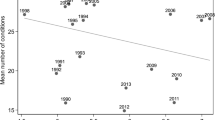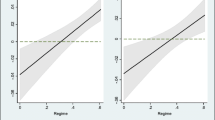Abstract
The advent of merit-based state financial aid programs has had several first order effects, such as changes in enrollment. However, these programs may also have second order effects, such as declining state support for need-based state financial aid programs. I hypothesize that the advent of merit-based state financial aid may be an example of Baumgartner and Jones’ punctuated equilibria. Results from estimation of models for dynamic panel data suggest instead that need-based aid has changed only incrementally in the states, without an observable effect of merit-based aid.


Similar content being viewed by others
Notes
As a check on possible issues of multicollinearity, I calculated variance inflation factors (VIFs) for the set of covariates included in the regressions. This involved two sets of calculations, one for the variables in nominal terms and the other for the variables after first differencing. None of the VIFs exceeded 4. The variable with the highest VIF was public four year tuition, with a VIF of 3.94 when entered in nominal terms and 1.32 when entered as a first difference.
References
Anderson, T., & Hsiao, C. (1982). Formulation and estimation of dynamic models using panel data. Journal of Econometrics, 18, 47–82.
Arellano, M., & Bond, S. (1991). Some tests of specification for panel data: Monte Carlo evidence and an application to employment equations. The Review of Economic Studies, 58(2), 277–297.
Baumgartner, F. R., & Jones, B. D. (1991). Agenda dynamics and policy subsystems. Journal of Politics, 53(4), 1044–1074.
Baumgartner, F. R., & Jones, B. D. (1993). Agendas and instability in American politics. Chicago: University of Chicago Press.
Beadie, N. (1999). From student markets to credential markets: The creation of the Regents examination system in New York State, 1864–1890. History of Education Quarterly, 39(1), 1–30.
Berdahl, R. O. (1978). In D. W. Breneman & C. E. Finn (Eds.), Public policy and private higher education (pp. 323–352). Washington, DC: Brookings.
Berry, W. D., Ringquist, E. J., Fording, R. C., & Hanson, R. L. (1998). Measuring citizen and government ideology in the American states, 1960–93. American Journal of Political Science, 42(1), 327–348.
Binder, M., & Ganderton, P. T. (2002). Musical chairs in higher education: Incentive effects of a merit-based state scholarship program. Department of Economics Working Papers, University of New Mexico.
Blaydon, C. (1978). In D. Breneman & C. J. Finn (Eds.), Public policy and private higher education (pp. 353–388). Washington, DC: The Brookings Institution.
Bond, S. R. (2002). Dynamic panel data models: A guide to micro data methods and practice. Portuguese Economic Journal, 2002(1), 141–162.
Cornwell, C., Mustard, D. B., & Sridhar, D. J. (2006). The enrollment effects of merit-based financial aid: Evidence from Georgia’s hope program. Journal of Labor Economics, 24(4), 761–786.
Creech, J. D., & Davis, J. S. (1999). Merit-based versus need-based aid: The continual issues for policymakers. In J. King (Ed.), Financing a college education: How it works, how it’s changing. Phoenix: ACE/Oryx.
Doyle, W. R. (2006). Policy adoption of merit-based student grant programs: An event history analysis. Educational Evaluation and Policy Analysis, 28(3), 259–285.
Doyle, W. R. (2008). Access, equity and excellence: The competing goals of state student financial aid. In The effectiveness of student aid policies: What the research tells us (pp. 159–188). New York: College Board.
Dynarski, S. M. (2000). Hope for whom? Financial aid for the middle class and its impact on college attendance. National Tax Journal, 53(3), 629–663.
Dynarski, S. M. (2002). The consequences of merit aid. National Bureau of Economic Research Working Papers (9400).
Dynarski, S. M. (2003). The new merit aid. Cambridge: Harvard University, Kennedy School of Government.
Dynarski, S. M., & Scott-Clayton, J. E. (2006). The cost of complexity in federal student aid: Lessons from optimal tax theory and behavioral economics. National Tax Journal, 59(2), 319–356.
Ellwood, D., & Kane, T. J. (2000). Who is getting a college education? Family background and growing gaps in enrollment. In S. Danziger & J. Waldfogel (Eds.), Securing the future: Investing in children from birth to college. New York: Russel Sage Foundation.
Greene, W. H. (2003). Econometric analysis. Upper Saddle River, NJ: Prentice-Hall.
Griswold, C. P., & Marine, G. M. (1996). Political influences on state policy: Higher-tuition, higher-aid, and the real world. Review of Higher Education, 19(4), 361–389.
Hauptman, A. M. (2001). Reforming the ways states finance higher education. In D. E. Heller (Ed.), The states and higher education policy. Baltimore: Johns Hopkins University Press.
Hearn, J. C., & Longanecker, D. (1985). Enrollment effects of alternative postsecondary pricing policies. Journal of Higher Education, 56(5), 485–508.
Heller, D. E. (1997). Student price response in higher education: An update to Leslie and Brinkman. Journal of Higher Education, 68(6), 624–659.
Heller, D. E. (1999). The effects of tuition and state financial aid on public college enrollment. The Review of Higher Education, 23(1), 65–89.
Heller, D. E. (2002). The policy shift in state financial aid programs. In J. C. Smart (Ed.), Higher education: Handbook of theory and research (Vol. XVII, pp. 221–262). New York: Agathon.
Heller, D. E., & Marin, P. (2002). Who should we help? the negative social consequences of merit scholarships (Tech. Report). Harvard University Civil Rights Project.
Heller, D. E., & Marin, P. (2004). State merit scholarship programs and racial inequality (Tech. Report). Harvard University Civil Rights Project.
Hoenack, S. (1982). Pricing and efficiency in higher education. Journal of Higher Education, 53(4), 403–418.
Jack, H. L. (2006). Investing in educational opportunity: Strengthening Tennessee’s commitment to low-income students and families (Tech. Report). Nashville: Tennesse Independent Colleges and Universities Association.
Klingman, D., & Lammers, W. W. (1984). The “general policy liberalism” factor in American state politics. American Journal of Political Science, 28(3), 598–610.
Leslie, L. L., & Brinkman, P. T. (1987). Student price response in higher education: The student demand studies. Journal of Higher Education, 58(2), 181–204.
Lindblom, C. (1959). The science of muddling through. Public Adminsitration Review, 19, 79–88.
McDonough, P. M., Calderon, S. M., & Purdy, W. C. (2007). State grant aid and its effects on students’ college choices (Tech. Report). Boulder, CO: Western Interstate Commission on Higher Education.
Mortenson, T. G. (1997). Georgia’s HOPE scholarship program: Good intentions, strong funding, bad design. Postsecondary Education Opportunity, 56, 1–3.
National Center for Public Policy and Higher Education. (2002). Losing ground: A national status report on the affordability of higher education (Tech. Report). NCPPHE.
Parsons, M. D. (1997). Power and politics: Federal higher education policymaking in the 1990’s. Albany: State University of New York Press.
Selingo, J. (2001). Questioning the merit of merit scholarships. The Chronicle of Higher Education, 47(19), 20–22.
Tennessee Higher Education Commission. (2007). Tennessee education lottery scholarship program annual report (Tech. Report). Nashville: THEC.
Turner, C. S. V., Jones, L. M., & Hearn, J. C. (2004). Georgia’s P-16 reforms and the promise of a seamless system. In M. W. Kirst & A. Venezia (Eds.), From high school to college: Improving opportunities for success in postsecondary education. San Francisco: Jossey-Bass.
United States Department of Commerce, Bureau of Economic Analysis. (2003). National income and product accounts (No. 3/5/2003). Bureau of Economic Analysis.
US Department of Education. (2001). Digest of education statistics, 2000 (Tech. Report). National Center for Education Statistics.
Author information
Authors and Affiliations
Corresponding author
Rights and permissions
About this article
Cite this article
Doyle, W.R. Does Merit-Based Aid “Crowd Out” Need-Based Aid?. Res High Educ 51, 397–415 (2010). https://doi.org/10.1007/s11162-010-9166-3
Received:
Published:
Issue Date:
DOI: https://doi.org/10.1007/s11162-010-9166-3




